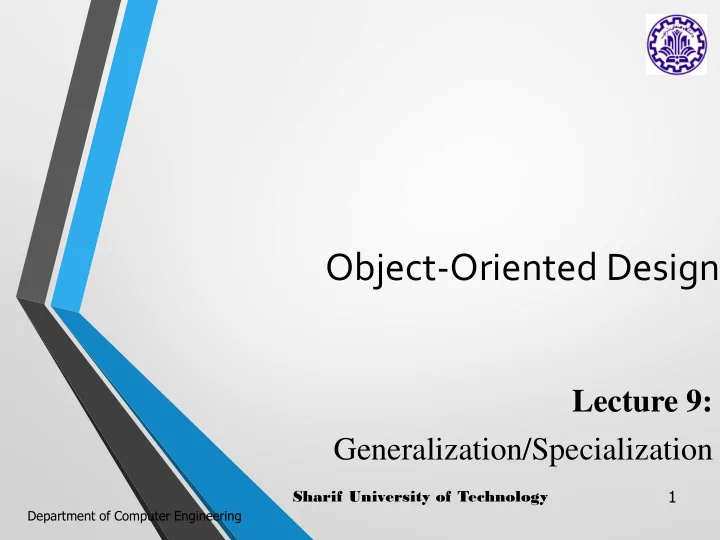

Object-Oriented Design Lecture 9: Generalization/Specialization Sharif University of Technology 1 Department of Computer Engineering
Analysis Workflow: Analyze a Use Case • The analysis workflow consists of the following activities: • Architectural analysis • Analyze a use case • Outputs: • analysis classes • use case realizations • Analyze a class • Analyze a package 2 Sharif University of Technology
Generalization • Generalization is a relationship between a more general thing and a more specific thing: • the more specific thing is consistent in every way with the more general thing. • the substitutability principle states that you can substitute the more specific thing anywhere the more general thing is expected. • generalization applies to all classifiers and some other modeling elements. 3 Sharif University of Technology
Generalization/Specialization • Generalization hierarchies may be created by generalizing from specific things or by specializing from general things. 4 Sharif University of Technology
Inheritance • Class inheritance is implicit in a generalization relationship between classes. • The subclass inherits the following features from its parents - attributes, operations, relationships, and constraints. 5 Sharif University of Technology
Inheritance: Overriding • Subclasses may: • add new features; • override inherited operations: • the subclass provides a new operation with exactly the same signature as the parent operation it wishes to override; the operation signature consists of an operation name, types of all parameters in order, and return type. 6 Sharif University of Technology
Abstract Operations and Classes • Abstract operations are designed to have no implementation: • they serve as placeholders; • all concrete subclasses must implement all inherited abstract operations. • An abstract class has one or more abstract operations: • abstract classes can't be instantiated; • abstract classes define a contract as a set of abstract operations that concrete subclasses must implement. 7 Sharif University of Technology
Abstraction Level • all things at the same level in a generalization hierarchy should be at the same level of abstraction. 8 Sharif University of Technology
Polymorphism • Polymorphism means "many forms". It allows you to design systems using an abstract class, then substitute concrete subclasses at runtime - such systems are very flexible and easy to extend; just add more subclasses. • Encapsulation, inheritance, and polymorphism are the "three pillars" of OO. 9 Sharif University of Technology
Polymorphism: Example 10 Sharif University of Technology
Polymorphism: Concrete Operations • Polymorphic operations have more than one implementation: • different classes may implement the same polymorphic (abstract/concrete) operation differently; • polymorphism allows instances of different classes to respond to the same message in different ways. 11 Sharif University of Technology
Advanced Generalization: Generalization Sets • Generalization set - a set of subclasses organized according to a particular rule; constraints: • {complete} - generalization set contains all possible members; • {incomplete} - generalization set does not contain all possible members; • {disjoint} - an object may be an instance of no more than one of the members of the generalization set; • {overlapping} - an object may be an instance of more than one of the members of the generalization set; • {incomplete, disjoint} - the default. 12 Sharif University of Technology
Generalization Sets: Implementation 13 Sharif University of Technology
Generalization Sets: Example 14 Sharif University of Technology
Reference • Arlow, J., Neustadt, I., UML 2 and the Unified Process: Practical Object- Oriented Analysis and Design , 2 nd Ed. Addison-Wesley, 2005. 15 Sharif University of Technology
Recommend
More recommend